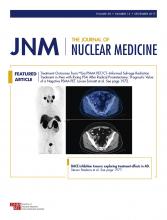REPLY: We thank Lu et al. for their comments. We certainly agree with many and, most importantly, that “Imaging of cardiac sarcoidosis remains challenging” for us all. To answer their specific points, first, regarding the duration of dietary preparation, our patients were recommended to consume two high-fat, low-carbohydrate meals, as is consistent with recent guidelines (1). We specifically choose not to exclude noncompliant patients because we wanted to challenge our readers with a spectrum of real-world cases.
Second, Yu et al. make a good point about correlating the 18F-FDG PET/CT results with the results of other types of imaging, such as cardiac MRI, and with clinical findings. We are looking at this in other ongoing projects and did not think it was needed for the main message of the current paper (2).
Third, regarding Figures 1 and 2, we did not screen the entire set of images but chose the first good examples identified. Also, the fact that Yu et al. do not agree with our image interpretation absolutely highlights the main message of our paper. For Figure 1B, Yu et al. correctly point out the issue of papillary muscle activity; however, the patient also clearly had basal anterior uptake and patchy right ventricular uptake consistent with the “focal on diffuse” pattern. Whether this pattern should be considered indeterminate for cardiac sarcoidosis is controversial. However, the recent SNMMI–ASNC expert consensus document (1) considered the “focal on diffuse” pattern to be consistent with possible inflammation. Further, the consensus document specifically highlights the importance of the location of the abnormal focal uptake in this situation (1). For Figure 2B, there is faint diffuse myocardial uptake; poor preparation may have contributed to this finding, but the lateral uptake intensity is in keeping with a normal variant (1,3,4).
Finally, we agree with the comment that it is possible that, with a modified patient preparation protocol (e.g., with 72 h of dietary preparation (5)), we might have achieved even greater interobserver agreement. However, the value, patient compliance with, and practically of very prolonged diet preparation have not been tested prospectively. Our work sets a standard against which subsequent research can be measured, and we very much hope that interreader variability can be greatly improved. Further research such as this is vitally important because clinicians caring for patients with cardiac sarcoidosis base important management decisions on 18F-FDG PET imaging results.
Footnotes
Published online Oct. 19, 2017.
- © 2017 by the Society of Nuclear Medicine and Molecular Imaging.







